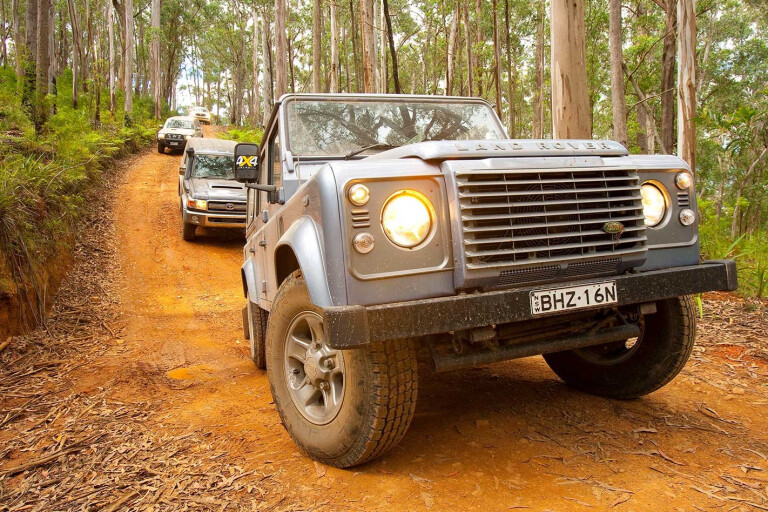
Not having had all of these vehicles side by side in comparison before, we decided to head bush and give them a thorough work out. The very steep terrain and water crossings of Deua NP, NSW, threw up challenges a-plenty – just perfect for our pursuit of bush touring excellence in this quartet.
This feature was originally published in 4x4 Australia’s May 2009 issue
On-road Performance and Refinement
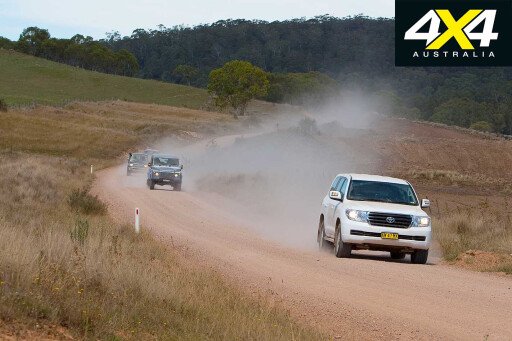 The LandCruiser 200 GXL diesel is by far the best performing and most refined vehicle to drive on road. It outpowers the others by a country mile, is deathly quiet and its optional Kinetic Dynamic Suspension System (KDSS) keeps the big machine flat through the ‘twisties’.
The LandCruiser 200 GXL diesel is by far the best performing and most refined vehicle to drive on road. It outpowers the others by a country mile, is deathly quiet and its optional Kinetic Dynamic Suspension System (KDSS) keeps the big machine flat through the ‘twisties’.
The left-side ends of the front and rear anti-sway bars are fitted with cylinders that are hydraulically linked by a pair of lines running along the inside of the left chassis rail. When the vehicle is cornering on-road the cylinders are in phase, so the hydraulic lines ‘lock’ and the anti-sway bars act to resist body roll.
Downsides of the 200 on road are front seats that don’t height adjust, so shorties struggle to see over the bonnet, and a double overdrive transmission that won’t pick up sixth unless you’re speeding.
Next best on road, surprisingly, is the LandCruiser 76 wagon. Although a little weird in behaviour, thanks to coils up front, leaves down the back and 100mm difference between front and rear axle tracks, the ancient-looking 76 performs and handles quite well.
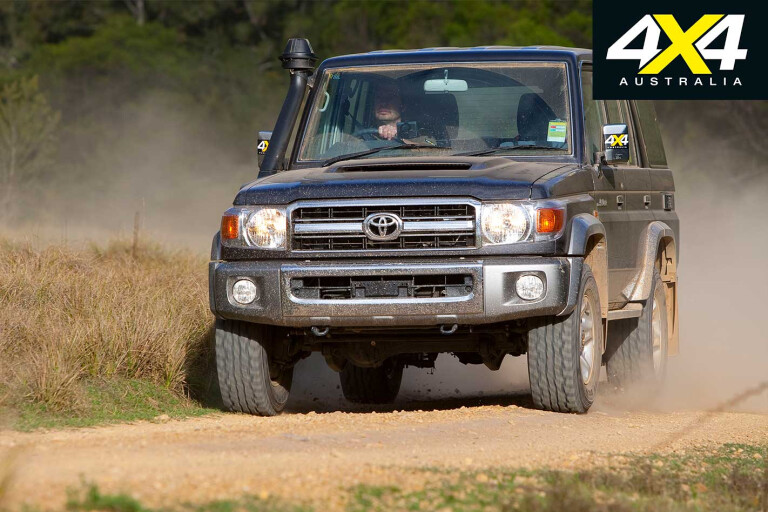
The single-turbo V8 is one of the most responsive engines ever put into a 4X4 and works well with the slick five-speed box. A taller overdrive would drop revs at cruising speeds and cruise control should be standard.
The Patrol’s auto box and better cabin comfort and equipment shades the Defender on-road, but it is a close-run thing. The Patrol’s revvy, asthmatic 3.0-litre diesel is a shocker, needing a bootful of revs to maintain cruising speeds, even on gently undulating roads.
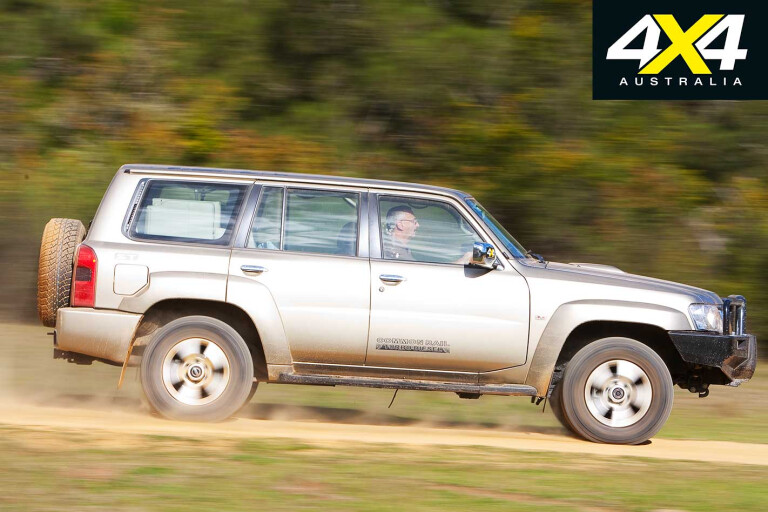
The Defender doesn’t like hills, either, but it performs better than previous Land Rover aluminium-boxes-on-wheels, so that’s a plus. The six-speeder gives a good gearing spread, but the action is ‘baulked’ easily if revs aren’t right and the clutch pedal is very heavy. There’s no cruise control, the seating position is awful and two-hourly driving breaks are essential to stave off cramps.
In terms of on-road touring safety, the 200 and the Patrol are SRS-equipped and all but the 76 Series have ABS brakes. The 76 will be scoring much needed safety upgrades later this year.
Off-road Capability

We picked this foursome for their off-road credentials, so it was hardly surprising to see them all perform highly off-road.
The champ was the 76, thanks to its combination of conservative tare weight, deep-reduction gearing, ‘luggable’ engine with idle-up control, optional twin diff locks, live-axle wheel travel, standard snorkel, good ground clearance and generous belly/approach/departure angles.
The Defender should have rivalled the 76, because it comes with all-coil suspension, traction control, better chassis angles and ground clearance, but Land Rover has stiffened the suspension, probably in the interests of more stable on-road handling, and this upset its off-road grip. Also, the turbo airflow fell off dramatically below 2000rpm, so it was easy to get stranded mid-hill, with no-one home.
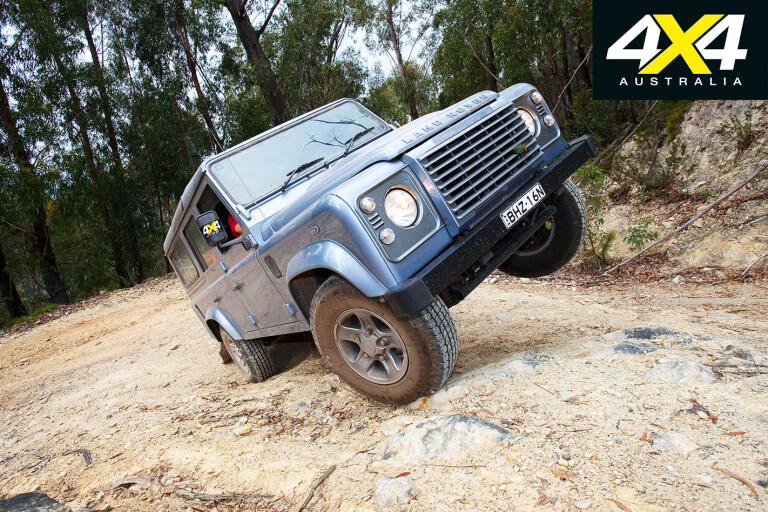
The test 200 came with traction and hill-descent control and KDSS, but was ‘nobbled’ to a large extent off road by its weight, bulk and lack of ground clearance. Vision of the track and the vehicle’s extremities is poor and the 200 is too wide for bush tracks pioneered by narrower Toyotas, so the panels and paintwork are constantly at risk.
The Patrol has the least off-road traction aids, but Patrols have always had powerful limited-slip rear differentials, so the test vehicle clambered where the others did. However, like the 200, it dragged its low-slung rear bumper across drainage humps and its revvy engine saw it working hard in conditions the others handled more easily.
Touring Range

The LandCruiser 200’s 138-litre tankage and its relatively frugal 15.4L/100km consumption made it the best bush tourer on this test, with a practical range of 850-plus-km. However, that’s marginal for long hauls such as the Simpson Desert and the Canning Stock Route.
The others were well off the pace, with the Defender good for less than around 530km and the LandCruiser 76 safe at around 600km.
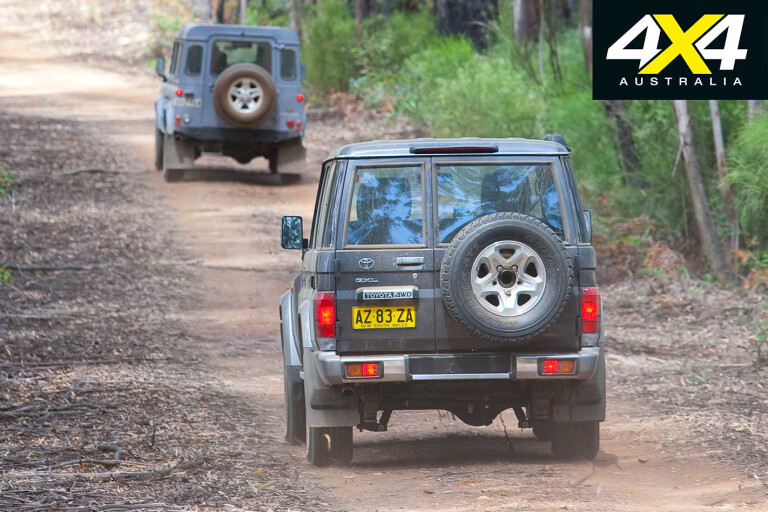
The Patrol’s 95L plus 32L tanks suggest good touring range, but the engine works hard and drinks like a sailor in the process. You can rely on only 660-plus-km out of the Patrol.Long range tanks are available for all these vehicles and should be part of a pre-trip modification process.
Around town

The 200 Series had more creature comforts than the others and much better noise, vibration and harshness quality – and so it should at the heady price Toyota demands for it. But it’s a bulky beast with blind vision corners, so it’s a handful in congested areas.
Plusses for the 200 as a town wagon are its smooth power delivery, smooth-shifting transmission and the capacity to seat five adults and three kids. The Bluetooth phone system is easy to set.

The Patrol fits better than the 200 into parking spaces, unless there’s restricted turning space, when its vast turning circle becomes a problem. The engine characteristics force the transmission to shuttle back and forth in hilly situations, making progress jerky and noisy. The rumoured V6 diesel can’t come soon enough.
The 76’s lack of SRS and ABS probably keeps the driver focused on avoiding an accident and its generally good road manners and powerful brakes assist in this regard.
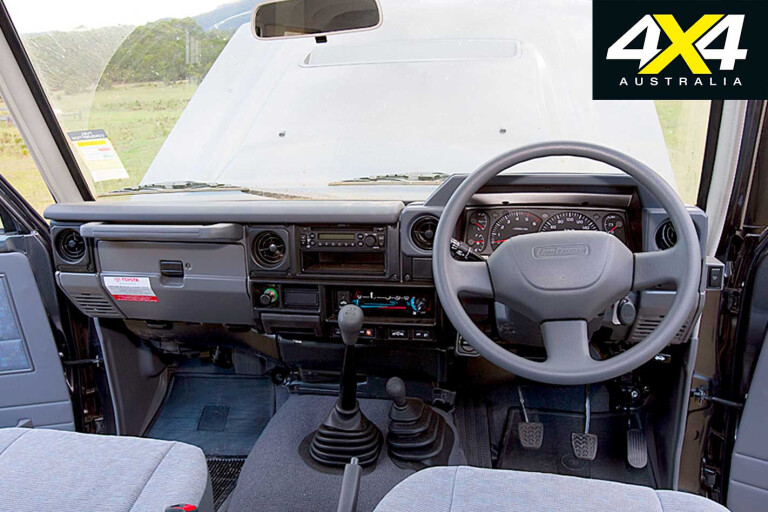
The gorgeously flexible engine means town driving is done mainly in fourth and fifth cogs, with second-gear starts possible on flat ground. It’s possible to skip-shift a lightly loaded 76, using first, third and fifth for smooth acceleration.
Why anyone would want to drive a Defender around town is beyond me. The combination of heavy clutch, ergonomically disastrous driving position, gigantic turning circle, steep climb to get in and out, total lack of secondary safety, toy mirrors and wipers, car park height limitation and firm ride combine to make the Defender a town horror. It’s at its best in the wide open spaces.
Long Distance Driving
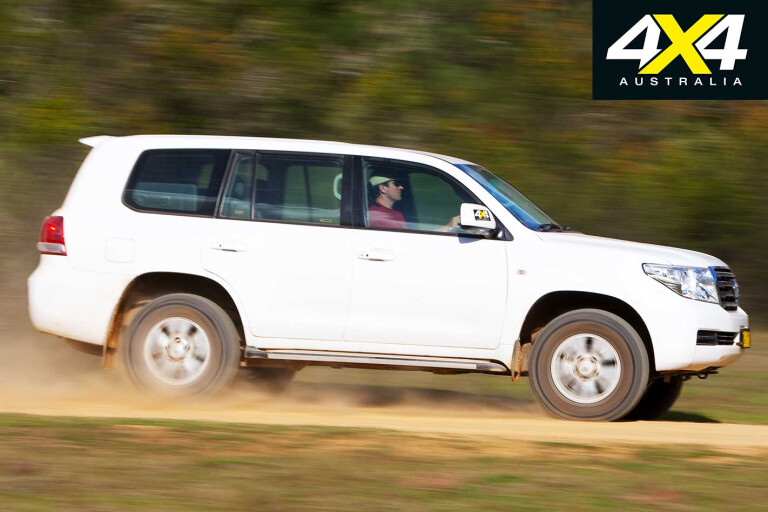
The 200 Series is an effortless cruiser, with its smooth ride, MP3 sound system, automatic transmission, torquey engine, cruise control and low NVH levels. But the big Cruiser doesn’t like rough roads very much and its standard dampers run out of shock absorbing power very quickly, letting the soft front-end nod annoyingly and the live-axle rear leap about.
The absence of driver’s seat adjustment means it either suits you or it doesn’t. It doesn’t suit me at all.
The Patrol is fine on long, flat stretches where its underdone engine doesn’t have to work very hard. Like the Cruiser the Patrol has weak dampers that allow the axles to move around excessively on rough surfaces. The cruise control works well and multiple adjustments permit different drivers to tailor seat comfort.

The 76 lopes along effortlessly over long distances, but this ease is balanced by the need to keep pressure on the accelerator. Why no cruise control, Toyota? The sound system is a disgrace and the driver’s seat adjusts only for reach. However, the standard suspension works surprisingly well on all surfaces.
The Defender has the same problems as the 76, but they’re exacerbated by worse ergonomics. On top of that, the too-firm coils bang about on the rough stuff, making the vehicle feel somewhat like a leaf-sprung Series II. – Allan Whiting
Space Pace
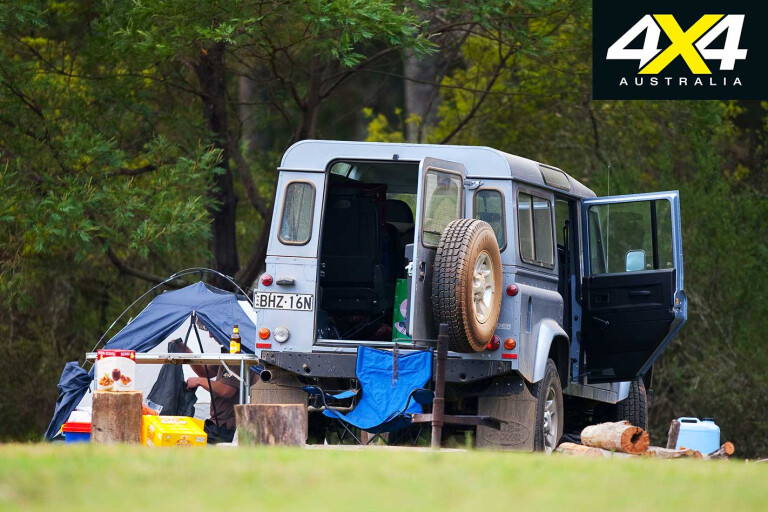
So you want to ‘get away from it all’ for a while, but you need to take some of it with you, too, plus add a bit of extra safety and convenience gear to the vehicle. The four vehicles here are all capable of swallowing enough gear for extended bush touring but some, as we found out, do it better than others in showroom trim, while the two more basic vehicles we’re driving here – Defender and Cruiser 76 – offer great opportunity for ‘suit-yourself’ bush tourer fit-outs.
We’ll start by looking at the Defender for no other reason than it’s been a favourite bush tourer for generations of adventurers and remote area workers, and it’s arguably the easiest to modify and specify for bush work.
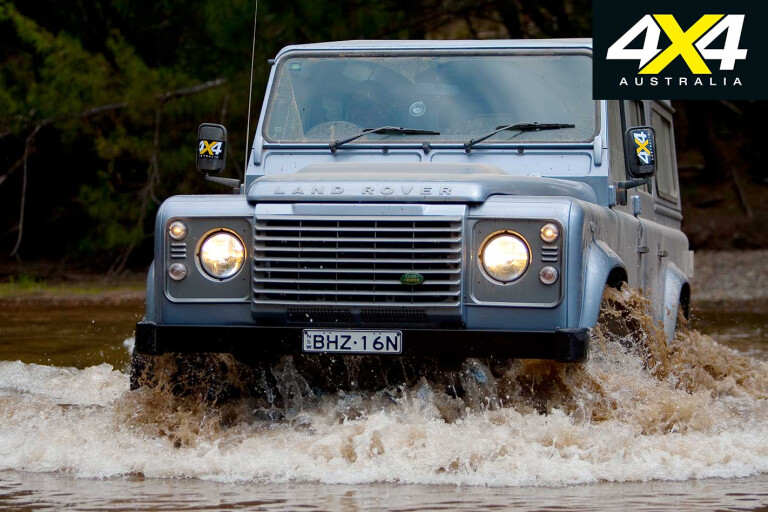
Ours was fitted with the optional third-row seating which, to be frank, made it very difficult to pack with our usual bush equipment. When folded, the second-row seats leave buttress-like mounts protruding above floor level. Our ‘test’ kit of a fridge, first aid kit, two gear bags, a backpack and a swag fitted, but it was tight between those folded rear seats.
The fold-down rear step below the door is a nice touch but no matter what way you look at it, the side-swing rear door (with spare) is narrow and disinclined to remain open on anything other than flat ground. Many of us take a fridge into the bush but the usual in-the-rear, slide-out fridge installation is impossible with the Defender.
But strip the seats from the Defender and most of those cargo compromises disappear. The flat-floored and square-cornered layout means easy fit-out. The floor covering is tough rubber which is easily removed and replaced – and doesn’t hide any reinforcing ribs to mess up levels. And it’s tall enough to stand in, albeit stooped.
 Picture: Land Rover Defender rear cargo space
Picture: Land Rover Defender rear cargo space
The boxy body and open-under mudguards make installing extra tanks a cinch. You can load 150kg on the roof – that’ll be a rooftop tent on a rack, plus two jerries of fuel.
The Toyota Defender… er, LandCruiser 76 GXL wagon’s barn doors open easily to reveal plenty of load area. The bench rear seat – it seats five, not seven like our optioned test Defender – flips forward but would be easily removed for months of travelling, two-up.
It doesn’t match the Defender’s ultimate ‘blank canvas’ versatility, but comes close and will of course take a fridge in the ‘typical’ position. The tie-downs are sensibly installed in each corner of the load floor. Aftermarket modular storage systems abound for this Toyota and its bigger brother.
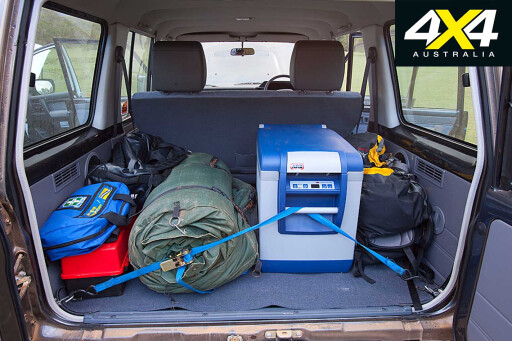 Picture: Toyota LandCruiser 76 Series rear cargo space
Picture: Toyota LandCruiser 76 Series rear cargo space
More interior plastic makes the 200 Series a little more delicate when loaded and the rear quarter sections are thick. Drop down tailgate is appreciated for lunches on the run with (some) shelter above. Away from Saturday morning soccer runs, the rear seats intrude – a delete-option five-seat Cruiser GXL would make so much sense. Full-circle tie downs are concealed below the carpet so they’re out of the way when not in use.
Behind its barn doors (like the Cruiser 76) the Nissan has a generous load area. It’s a little lower than the 76 but the forward tie-downs are only half-way along the load area and the sideways rear seats are a hindrance.
 Picture: Nissan GU Patrol rear cargo space
Picture: Nissan GU Patrol rear cargo space
The rear seats are relatively easy to remove (Nissan offers the ‘option’ of no rear seats in its base-model DX). The Nissan is the only one of this four with a 12V outlet in the cargo area – a silly omission on the other three – but being switched by ignition limits its use.
For what it is worth, the Nissan and Toyota 76’s jacks are easily accessed in the (right and left respectively) rear corners of the vehicles. The 200 is tucked a little deeper into the right rear so would be more difficult to access when loaded. The Landie’s is stored under the flip-up passenger front seat.
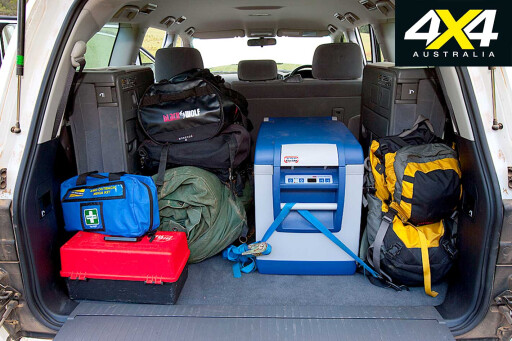 Picture: Toyota LandCruiser 200 series rear cargo space
Picture: Toyota LandCruiser 200 series rear cargo space
Load & Tow
The sheer size of the 200 Series allows it to swallow lots of gear but its 600kg payload is easily accounted for with bar work, aftermarket fuel tank, extra spare and the fridge – more on that in a moment. Cruiser can take 150kg on the roof.
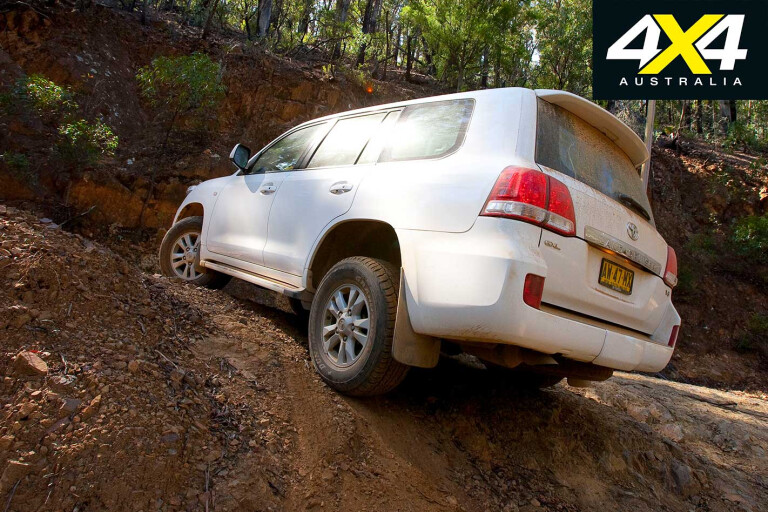
Surprisingly 569kg is the payload limit in the Patrol ST-L (it’s a little more with the base-model DX) including 120kg on the roof which is just adequate for a roof-topper and its rack.
The 76 can carry 150kg on the roof and has an all-up payload of 810kg.
The Defender offers in excess of one tonne carrying capacity so you can pack as much camping gear and fuel on board as you want. Maximum roof load is 150kg.
Both Toyotas and the Defender can tow 3500kg. The Nissan ST-L 3.0-litre turbo-diesel auto is limited to 2500kg. Common sense says you wouldn’t attempt that beyond smooth gravel roads but, with capabilities like that, a 1200kg camper trailer won’t be stressing the driveline of any of these in off-road conditions.
All the Gear
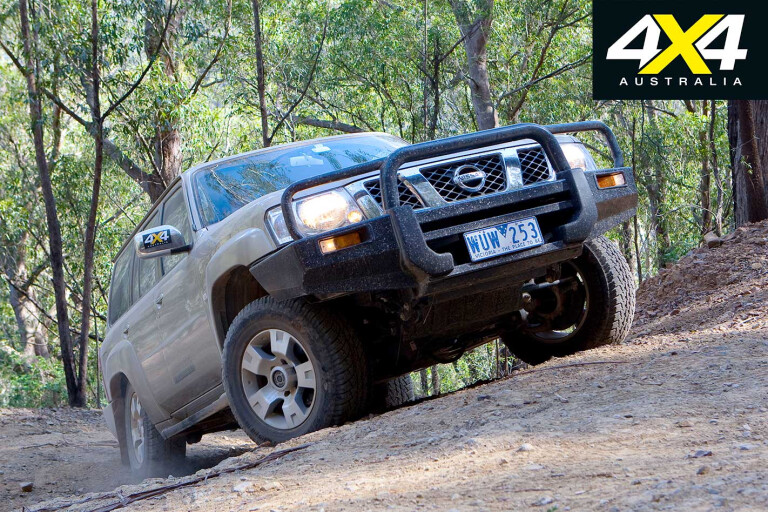
Aftermarket accessories support is generous for these regal bush tourers. The bush basics of winch bar, snorkel, cargo barrier, roof rack and long-range fuel tank are all easily bought items for all, with a possible ‘made-to-order’ situation for some Land Rover hardware (such as long-range fuel tanks) due to the marque’s comparatively low sales volume.
The Cruiser 76 is especially noteworthy (and appealing) for its standard snorkel and optional diff-locks. That means Toyota warranty and no extra time in a workshop preparing for the trip. Toyota’s 76 snorkel is a two-piece item but the join is above the height where the vehicle will be inundated. The Nissan, 200 and Defender have aftermarket locking diffs available for owners who require them.
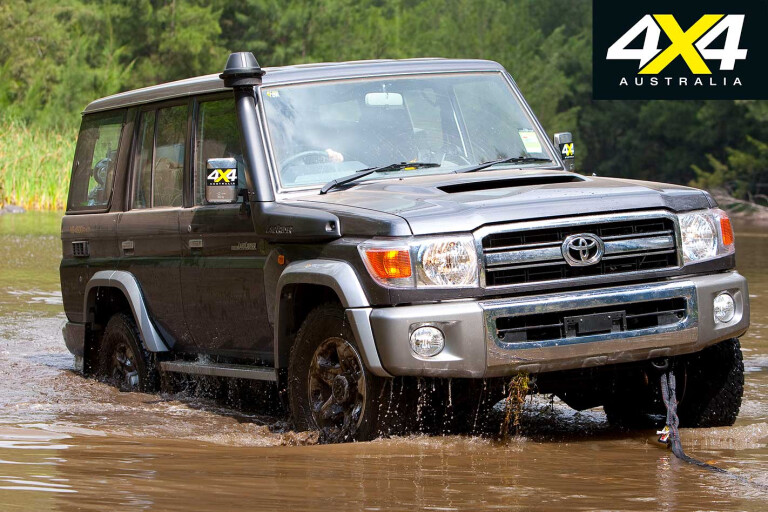
Suspension upgrades and lifts are a snack, including certified GVM upgrades: a necessary evil for 200s and Nissans loaded with gear and clobber for a family. The Defender, especially, would benefit from a softer spring/damper combo if it’s not to tow or be loaded a lot.
Outback servicing is a moot point these days. Owners with limited experience cause harm by ‘precautionary’ inter-services campsite de-dusting of air cleaners (which often introduces dust to the intake sensors etc) then blame ‘the electronics’. Poorly designed or incorrectly installed aftermarket gear often causes dramas, too: sump plate retaining bolts can foul on radiator tanks; battery trays can crack firewalls.

And what about the persistent grey cloud over Land Rover spare parts? Reality is, no dealer marque stocks much in the way of spare parts with components beyond consumables shipped by air/mail overnight. Anyone with an ounce of nous will carry spare belts, filters and hoses so shouldn’t really need to rely on external support networks in the short term. – Glenn Torrens
Staff Picks
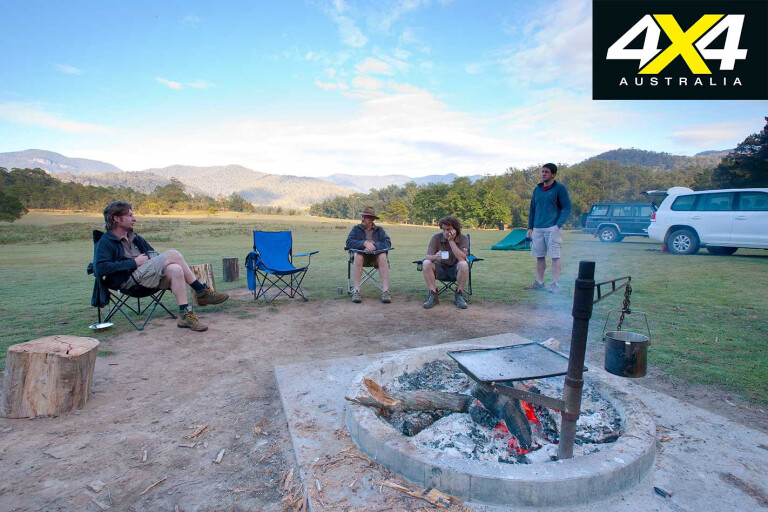
"Of these four, the 76’s grunt, efficiency and layout is the best suited for where I want to go and what I want to do. I’d fling the rear seats and fit it out for touring but no way could it be my ‘daily driver’."
– Glen Torrens
"The 76 is my pick of this bunch. It’s close to bush ready out of the box, but I’d fiddle the suspension and fit Recaros, a long-range tank, cruise control and a decent sound system."
– Alan Whiting
"Despite the 200’s comfort and prowess on the hills, the 76 inspires more confidence. The single-turbo V8 is more enjoyable, the 76’s suspension takes more of a pounding and the scale of the vehicle is much more manoeuvrable." – TS
"The 200 Series is my choice simply for the fact that the soft suspension can be easily fixed and you get that sweet engine. Pack smart (and light) and it is a top tourer. Plus, allowing for its bulk, it is surprisingly easy to drive around town." – Justin Walker
"The best bush tourer is the 76 Series. With its outstanding performance and good fuel economy, it makes tackling almost any terrain a breeze. But value for money isn’t great and basic interior lets it down." – ME
Specifications
| Land Rover Defender 110 | Nissan Patrol 3.0 ST-L | Toyota LandCruiser 76 Series | Toyota LandCruiser 200 GXL V8 | |
|---|---|---|---|---|
| Base Price | $48,990 | $62,990 | $59,990 | $83,990 |
| Engine | ||||
| Type | 2402cc four-cylinder DOHC, common-rail intercooled turbo-diesel | 2953cc four-cylinder DOHC, common-rail intercooled turbo-diesel | 4461cc V8 DOHC, common-rail intercooled turbo-diesel | 4461cc V8 DOHC, common-rail intercooled twin turbo-diesel |
| Bore/Stroke | 89.9 x 94.6mm | 96.0 x 102mm | 86.0 x 96.0mm | |
| Compression | 17.5:1 | 17.9:1 | 16.8:1 | |
| Power | 90kW @ 3500rpm | 118kW @ 3400rpm | 151kW @ 3400rpm | 195kW @ 3400rpm |
| Torque | 360Nm @ 2000rpm | 380Nm @ 2000rpm | 430Nm @ 1200-3200rpm | 650Nm @ 1600-2600rpm |
| Transmission | ||||
| Type | 6-speed manual | 4-speed auto | 5-speed manual | 6-speed auto |
| Ratios (overall) | ||||
| 1st | 5.443 (23.334/62.988) | 2.874 (12.574/25.399) | 4.529 (17.703/44.045) | 3.333 (13.028/34.109) |
| 2nd | 2.042 (7.999/15.197) | 1.544 (6.755/13.645) | 2.464 (9.631/23.961) | 1.960 (7.661/20.058) |
| 3rd | 1.721 (7.378/19.916) | 1.000 (4.375/8.838) | 1.490 (5.824/14.490) | 1.353 (5.288/13.846) |
| 4th | 1.223 (5.243/14.153) | 0.694 (3.036/6.133) | 1.000 (3.909/9.725) | 1.000 (3.909/10.233) |
| 5th | 1.000 (4.287/11.572) | - | 0.881 (3.443/8.566) | 0.728 (2.845/7.450) |
| 6th | 0.742 (3.181/8.587) | - | - | 0.588 (2.298/6.017) |
| Reverse | 4.935(21.156/57.109) | 2.275(9.953/20.105) | 4.313(16.859/41.945) | 3.061(11.965/31.325) |
| Final drive | 3.540:1 | 4.375:1 | 3.909:1 | |
| High ratio | 1.211 | 1.000 | ||
| Low ratio | 3.269 | 2.020 | 2.488 | 2.618 |
| Suspension | ||||
| Front | Live-axle, leading arms, Panhard rod, coil springs, gas/oil dampers | Live-axle, leading arms, Panhard rod, coil springs, gas/oil dampers, stabiliser bar | Live axle, leading arms, coil springs, gas/oil dampers, stabiliser bar | Independent, double wishbone, coil springs, gas/oil dampers, semi-active stabiliser bar, KDSS (optional) |
| Rear | Live-axle, A-arm, coil springs, gas/oil dampers | Live-axle, trailing arms, coil springs, gas/oil dampers, stabiliser bar | Live axle, leaf springs, gas/oil dampers | Live axle, four-link, coil springs, gas/oil dampers, semi-active stabiliser bar, KDSS (optional) |
| Steering | ||||
| Type | Power-assisted worm and roller | Power-assisted recirculating ball | Power-assisted rack and pinion | |
| Brakes | ||||
| Front | 298mm ventilated discs, ABS | 316mm ventilated discs, ABS | 322mm ventilated discs | 340mm ventilated discs, ABS, brake assist |
| Rear | 298mm solid discs, ABS | 330mm ventilated discs, ABS | 312mm ventilated discs | 345mm ventilated discs, ABS, brake assist |
| Wheels | ||||
| Material | Alloy | |||
| Size | 16x7.0J | 17x8.0J | 16x7.0J | 17x8.0J |
| Tyres | ||||
| Type | General Grabber | Bridgestone Dueler H/T | Dunlop Grandtrek | |
| Size | 235/85R16 V | 275/65R17 | 265/70R16 115R LT | 285/65R17 116H |
| Dimensions | ||||
| L/W/h | 4639/1790/2021mm | 5050/1940/1855mm | 4770/1870/1940mm | 4950/1970/1905mm |
| Wheelbase | 2794mm | 2970mm | 2730mm | 2850mm |
| Track (f/r) | 1486/1486mm | 1605/1625mm | 1555/1460mm | 1640/1635mm |
| Turning circle | 12.8m | 12.5m | 12.6m | 11.8m |
| Clearance | 314mm | 210mm | 215mm | 225mm |
| App/Dep/Ramp | 49º/34.6º/30.3º | 37º/31º/27º | 36º/23º/26º | 30º/20º/25º |
| Kerb Weight | 2041kg | 2451kg | 2190kg | 2630kg |
| GVM | 3050kg | 3020kg | 3000kg | 3300kg |
| Payload | 1010kg | 569kg | 810kg | 670kg |
| Fuel Tank | 75 litres, diesel | 125 litres, diesel | 90 litres, diesel | 138 litres, diesel |
| Fuel Consumption | 13.1L/100km | 17.9L/100km | 13.7L/100km | 15.4L/100km |
| Towing Capacity | ||||
| Braked | 3500kg | 2500kg | 3500kg | |
| Unbraked | 750kg | |||

COMMENTS